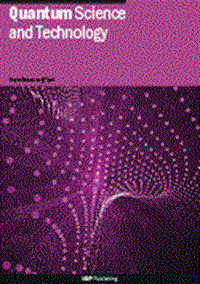多量子位点阵手术的空间并行解码
IF 5.6
2区 物理与天体物理
Q1 PHYSICS, MULTIDISCIPLINARY
引用次数: 0
摘要
运行受量子纠错保护的量子算法需要一个实时的经典解码器。为了防止积压信息的积累,这个解码器必须以比量子设备产生的更快的速度处理来自量子设备的综合症。大多数先前的实时解码工作都集中在表面码中编码的孤立逻辑量子位上。然而,对于表面代码,实用的量子程序将需要通过晶格手术进行多量子位相互作用。在晶格手术中可能会出现一个大的合并斑块,可能和整个设备一样大。这给实时解码器带来了很大的压力,它必须解码合并补丁上的错误,并保持在孤立的逻辑量子位上实现的容错水平。这些要求可以通过使用空间并行解码来放宽,这可以通过将设备上的物理量子位划分为多个重叠的组并为每个组分配一个解码器模块来实现。我们把这种方法称为空间平行窗口。虽然以前的工作已经探索了类似的想法,但没有一个解决与任务相关的系统特定考虑或使用硬件加速器的限制。在这项工作中,我们演示了如何配置空间并行窗口,使该方案(1)与硬件加速器兼容,(2)支持一般晶格手术操作,(3)保持逻辑量子位的保真度,以及(4)满足实时解码的吞吐量要求。此外,我们的结果揭示了最佳选择缓冲宽度以实现精度和吞吐量之间的平衡的重要性,这一决定应该受到设备物理噪声的影响。本文章由计算机程序翻译,如有差异,请以英文原文为准。
Spatially parallel decoding for multi-qubit lattice surgery
Running quantum algorithms protected by quantum error correction requires a real time, classical decoder. To prevent the accumulation of a backlog, this decoder must process syndromes from the quantum device at a faster rate than they are generated. Most prior work on real time decoding has focused on an isolated logical qubit encoded in the surface code. However, for surface code, quantum programs of utility will require multi-qubit interactions performed via lattice surgery. A large merged patch can arise during lattice surgery—possibly as large as the entire device. This puts a significant strain on a real time decoder, which must decode errors on this merged patch and maintain the level of fault-tolerance that it achieves on isolated logical qubits. These requirements are relaxed by using spatially parallel decoding, which can be accomplished by dividing the physical qubits on the device into multiple overlapping groups and assigning a decoder module to each. We refer to this approach as spatially parallel windows . While previous work has explored similar ideas, none have addressed system-specific considerations pertinent to the task or the constraints from using hardware accelerators. In this work, we demonstrate how to configure spatially parallel windows, so that the scheme (1) is compatible with hardware accelerators, (2) supports general lattice surgery operations, (3) maintains the fidelity of the logical qubits, and (4) meets the throughput requirement for real time decoding. Furthermore, our results reveal the importance of optimally choosing the buffer width to achieve a balance between accuracy and throughput—a decision that should be influenced by the device’s physical noise.
求助全文
通过发布文献求助,成功后即可免费获取论文全文。
去求助
来源期刊

Quantum Science and Technology
Materials Science-Materials Science (miscellaneous)
CiteScore
11.20
自引率
3.00%
发文量
133
期刊介绍:
Driven by advances in technology and experimental capability, the last decade has seen the emergence of quantum technology: a new praxis for controlling the quantum world. It is now possible to engineer complex, multi-component systems that merge the once distinct fields of quantum optics and condensed matter physics.
Quantum Science and Technology is a new multidisciplinary, electronic-only journal, devoted to publishing research of the highest quality and impact covering theoretical and experimental advances in the fundamental science and application of all quantum-enabled technologies.
 求助内容:
求助内容: 应助结果提醒方式:
应助结果提醒方式:


